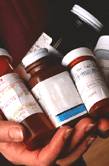- Navigating Your Midlife Crisis: Embracing New Possibilities
- City Raccoons Showing Signs of Domestication
- Mapping the Exposome: Science Broadens Focus to Environmental Disease Triggers
- One Week Less on Social Media Linked to Better Mental Health
- Your Brain Changes in Stages as You Age, Study Finds
- Some Suicide Victims Show No Typical Warning Signs, Study Finds
- ByHeart Formula Faces Lawsuits After Babies Sickened With Botulism
- Switch to Vegan Diet Could Cut Your Greenhouse Gas Emissions in Half
- Regular Bedtime Does Wonders for Blood Pressure
- Dining Alone Could Mean Worse Nutrition for Seniors
U.S. Hospitals See Big Rise in Drug-Related Suicide Attempts


Drug-related suicide attempts in the United States increased over a recent six-year period, with dramatic increases seen among young and middle-aged adults, health officials reported Thursday.
Overall, suicide attempts involving prescription medications and other drugs jumped by 51 percent among people 12 and older between 2005 and 2011, according to the Substance Abuse and Mental Health Services Administration (SAMHSA).
In two reports, the agency examines trends in ER visits for drug-related suicide attempts. The most significant increases occurred among adults younger than 30 — up 58 percent over the six years studied — and people between 45 and 64, who experienced a 104 percent spike in drug-related suicide attempts.
“We probably are seeing an increase in overall suicide attempts, and along with that we are also seeing an increase in drug-related suicide attempts,” said Peter Delany, director of the agency’s Center for Behavioral Health Statistics and Quality.
“People have access to medications, and they are using both prescription and over-the-counter meds,” he said. “It is clear that there are more drugs out there.”
Dr. Sampson Davis, an emergency room physician at Meadowlands Hospital Medical Center in Secaucus, N.J., agreed. “What we are seeing are the ramifications of the overuse of prescription drugs,” he said.
Davis added that the combination of these drugs and alcohol can be lethal.
“Patients who are taking [the painkiller] oxycodone and chasing it with a glass of wine only increase the chances of overdose,” he said.
By 2011, young and middle-aged people accounted for about 60 percent of all drug-related suicide attempts seen in emergency rooms, the researchers said.
The significant jump in suicide attempts by middle-age men and women may reflect the aging population as baby boomers enter middle-age, Delany said.
He’s concerned that middle-aged people get less attention than teenagers or the elderly who attempt to kill themselves. Many middle-age patients who attempt suicide are released from the emergency room without a follow-up plan, Delany said.
“We know the number one indicator of future suicide attempts and even suicide completion is a previous attempt,” he said. “For professionals in the emergency room, it’s really important that there be a really good discharge plan and some clear follow-up.”
In addition, you have to bring the family in, Davis said. “There really has to be a community effort to help people,” he added.
In one report, SAMHSA zeroed in on suicide attempts by people ages 45 to 64. In 2011, 96 percent of emergency room visits for attempted suicide involved the nonmedical use of prescription drugs and over-the-counter medications, the agency found.
These included anti-anxiety and insomnia medications (48 percent), pain relievers (29 percent), and antidepressants (22 percent).
Alcohol accounted for 39 percent of those mid-life suicide attempts and illegal drugs for 11 percent, the report said.
Dr. Eric Collins, an addiction psychiatrist at Silver Hill Hospital in New Canaan, Conn., said that as people age, they typically use less lethal means to attempt suicide — “pills versus guns.”
Collins said doctors need to be aware if their patients suffer from depression or anxiety. “These are treatable conditions,” he said.
But Davis added that mental health services are in short supply. “We need more treatment facilities,” he said.
“We also need to decrease the amount of prescription narcotics, sleep and anti-anxiety medications being prescribed,” he said. “Doctors aren’t to blame, but we must take ownership and responsibility for this.”
Analyzing ER visits by age, the SAMHSA researchers found the following:
- Treatment of 18- to 29-year-olds for drug-related suicide attempts rose from about 47,500 in 2005 to roughly 75,000 in 2011.
- Among people aged 45 to 64, these ER visits increased from about 28,800 to almost 58,800 in those years. Suicide attempts involving drugs doubled for both men and women in this age group, the researchers note.
- Overall, there were 228,277 drug-related suicide attempts in 2011, according to the agency.
More information
For more on suicide, visit the U.S. National Library of Medicine.
Source: HealthDay
Copyright © 2025 HealthDay. All rights reserved.










